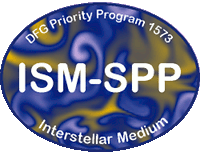DFG Priority Program 1573
Projects within the ISM-SPP
| Projects within the ISM-SPP | |
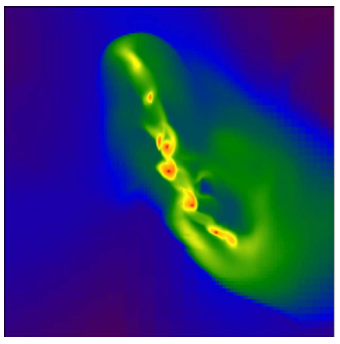 |
The low-metallicity ISM: Metal enrichment, chemistry, feedback and magnetic fieldsWe expore the properties of the low-metallicity ISM, i.e. the conditions of the interstellar gas at very early times, during the formation of the first stars and galaxies, and also in nearby dwarf galaxies with a rather small amount of previous metal-enrichment. We pursue a comprehensive approach that includes the most accurate modeling to date of the chemistry in low-metallicity gas, including the ionization degree and the consequences for non-ideal magneto-hydrodynamics (MHD) and dynamo amplification (sub-project CHEMPROP), the role of feedback like jets, outflows and supernova explosions in halos with virial temperatures below 104 K, both with respect to metal enrichment and the strength and structure of magnetic fields (sub-project MHDFEEDBACK), and finally the metal enrichment in the first galaxies, in halos with virial temperatures above 104 K, following metal-injection from multiple supernova events under MHD conditions (sub-project GALAXYSIM). The chemical networks, numerical simulations and non-ideal MHD models developed in this work will be made publicly available, in particular within the framework of the ISM-SPP. This work is timely and relevant due to the advent of ALMA and JWST, which will probe the low-metallicity ISM at high redshift.More information... Banerjee, Klessen, Schleicher |
 |
The Physical Conditions of the ISM in High-Redshift GalaxiesCharacterizing the physics governing the structure and evolution of the different phases of the interstellar medium lies at the heart of the new ISM-SPP. Recent progress on this in the Milky Way and nearby galaxies has been impressive - likewise, although much more difficult to observe, rapid progress has been made in observations of the ISM in distant galaxies, to which the PIs have contributed significantly. These studies show that the conditions in the ISM in the cosmic epochs where galaxies assembled and most stars and heavy elements were formed were distinctly different than what is found today. It is therefore crucial to investigate the structure, evolution, and physics of the ISM throughout cosmic time, and to follow how it relates to the processes that shape galaxies and govern the formation of stars. To contribute to this our proposed research program aims to (A) characterize the physical properties and structure of the high-redshift ISM through dedicated observations of low- and high-J CO transitions and high density tracers in star-forming galaxies, (B) obtain an unbiased sample of distant galaxies by observing a molecular deep field. Funding is requested for one experienced postdoc each at Bonn and Heidelberg, to conduct a comprehensive program that addresses core questions of the ISM-SPP and allows the continuation and focusing of our successful collaboration that already led to 32 joint, refereed publications.Bertoldi, Walter |
 |
Exploration of the physical conditions of gas in Local Group halosWe propose to study the neutral gas within the Local Group of Galaxies. The world's largest fully-steerable radio telescopes of both hemispheres have been used by us to prepare Galactic H I all-sky surveys. With the unprecedented sensitivity of the Effelsberg-Bonn HI Survey (EBHIS) and the Parkes Galactic All-Sky Survey (GASS) it gets possible to detect HI clouds with masses down to 2E4 Msun at the "rim" (1Mpc) of the Local Group. Now we intend to use these data to explore all over the sky the environments and physical states of dwarf galaxies, compact high-velocity clouds and high-velocity cloud complexes. This includes the extraplanar gas where we can resolve structures on pc scales. Such objects belong all to the Galactic halo but they are exposed to different environmental conditions: most important are the ionizing radiation field and the kinematical situation within the gravitational field of the Milky Way. We intend to extend our previous investigations all over the sky for an unbiased census of HI objects at high velocities. This includes the accretion history of galaxies, the composition of the multiphase coronal gas, phase transitions induced by turbulence and thermal instabilities and interactions with the magnetic field. We propose to generate a comprehensive data base of the ISM at high velocities with the aim to evaluate the physical properties and to trace the evolution of the interstellar medium on small as well as large scales.Ben Bekhti, Kerp |
 |
Experimental investigation of the collision and optical properties of (sub)micron-sized ice and ice-coated dust particlesWe propose to perform low-velocity impact experiments of (sub)micron-sized water ice, ice-coated silica, and pure silica particles with ice, silica, and ice/dust targets in a wide range of temperatures and under high-vacuum conditions. These experiments are intended to simulate inter-particle collisions in the densest and coldest interstellar clouds, for which grain growth by coagulation has been postulated and observed. Above all, we are interested in the sticking threshold for water-ice particles as a function of grain size, which is widely used in the literature but for which empirical data are lacking. On top of that, we also intend to measure the charge transfer in these collisions to assess whether triboelectric charging is a possible source for free charge carriers in dense interstellar clouds in which the classical sources of ionization, i.e. ultraviolet radiation and cosmic rays, are not effective. Our study will be complemented by infrared measurements of loose particle ensembles with which we will gain insight into the optical properties of coagulated spherical ice and ice-coated dust particles. A deeper understanding of the combined processes of coagulation, fragmentation, triboelectric charging, and optical properties of small particle agglomerates is required to calibrate models of the dust-mass evolution, the chemical evolution, and the radiative energy transport in molecular clouds.Blum |
 |
The effect of the environment on the Interstellar Medium of disk galaxiesThe space between the stars inside galaxies is filled by the interstellar medium (ISM), whose evolution is that of a multi-phase, compressible, magnetised and turbulent medium. Its complex and non-linear physics involve a huge range of spatial and temporal scales. Limits in computational power still force us to a make choice: either to study small ISM volumes at sub-pc resolution, or the global ISM of a galaxy with ~ 50 pc resolution and subgrid models for unresolved physics. This is unfortunate, because, both, small and large scales are important: Star formation and stellar feedback occur on sub-pc scales or even smaller. On the global scale, galaxies are embedded in their cosmic environment: most galaxies are not isolated but reside in galaxy groups or clusters, which are filled with a hot, tenuous intra-cluster medium (ICM). This exerts static and ram pressures onto the galaxies' ISM, with a magnitude comparable to ISM pressures. Consequently, the ISM responds to the cluster environment. We propose two major steps towards an integrated view of the ISM: (i) We study the coupling of the ISM to the ICM of the cluster environment. (ii) For this purpose, we combine ISM simulations on a galaxy-wide scale with simulations of a kpc-size volume of ISM resolved down to sub-pc scales. Thus, we use the unique cluster environment to get new insights into the physical processes in the ISM.Breitschwerdt, Brüggen |
 |
Probing the interstellar PAH hypothesis in electrodynamic trapsPolycyclic aromatic hydrocarbons (PAHs) are considered an important ingredient of the interstellar medium (ISM). Their presence is associated with the observation of unidentified infrared bands (UIRs) and diffuse interstellar bands (DIBs). They are thought to account for a substantial fraction of the carbon budget. However, not a single carrier of these bands has been identified. Even our understanding of the charge state or level of hydrogen saturation of these species in the ISM is rather poor due to a lack of laboratory data taken under conditions resembling those in the ISM. Experiments on PAHs in temperature variable ion traps will be carried out to understand their photophysics and chemistry. UV-absorption spectra of cold PAHs relate to the DIBs and reveal information on their photostability. IR spectra of species in different physical states will help to identify families of species in space. Emission from mass selected hot PAHs will be observed in a dedicated instrument and their thermal stability will be tested. Our goal is to observe a single trapped carbonaceous dust nanoparticle and follow its evolution while processing it with photons, electrons, atoms or molecules. These experiments are probing the presence and role of PAHs and small carbonaceous dust on the evolution of the ISM.Brünken, Schlemmer |
 |
Common Funds for SPP 1573We propose common funds for the organisation of the priority programme, for the organisation of conferences, workshops and soft skill seminars, for the planned international visitor programme and for observing trips of the participants. We apply for half a position for a postdoc (TVL 13) to create and maintain an ISM website and a centralised data space, to organise the international visitor programme as well as conferences, workshops and topical and soft-skills schools and to supervise the public outreach programme of the SPP.Burkert, Klessen |
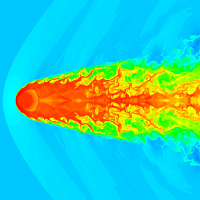 |
The physics of the interstellar medium under extreme conditions in Seyfert galaxiesWith the help of an optically and geometrically thick toroidal gas and dust structure around the central supermassive black hole, the so-called Unified Scheme of Active Galactic Nuclei geometrically unifies two observed classes of galaxies. Depending on the inclination of this dusty torus, the central active region is visible (Seyfert 1 galaxies) or not (Seyfert 2 galaxies). Despite successful observations with the largest available telescopes and interferometry in the mid-infrared, the detailed structure and physics of these objects as well as their origin is still poorly understood: What are the main drivers of turbulence in the nuclear regions and how do they structure the ISM and fuel the central black hole? How does nuclear activity affect the surrounding ISM? In our proposed model, nuclear star clusters in the central tens of parsec scale region provide the source for the ISM in the nucleus, which finally forms the turbulent torus on parsec scale. Thereby, our model links these two spatial regions, which are both well studied with adaptive optics and interferometric methods for a (common) sample of nearby Seyfert galaxies. The extreme conditions due to the presence of the central supermassive black hole lead to peculiar dynamical and structural properties of the turbulent ISM in galactic nuclei in comparison to our local ISM, which we propose to study in detail with three-dimensional magnetohydrodynamical simulations and their comparison with observations.More information... Ballone, Burkert, Plewa, Schartmann |
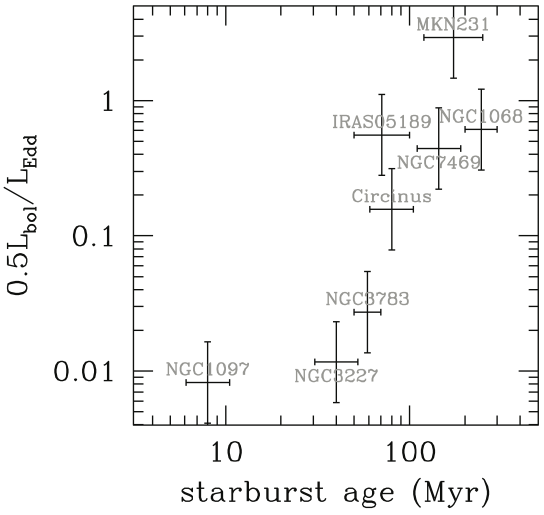 |
"Towards a comprehensive understanding of the interstellar medium in the extreme environment of Active Galactic Nuclei"A fundamental role is attributed to supermassive black holes in the evolution of galaxies. But theoretical models trying to reproduce the relation between black hole mass and stellar velocity dispersion and other relations, have to make broad assumptions about the physical processes involved, and the prescriptions used are poorly constrained. The implementation of AGN feeding and feedback in models remains simplistic because observations have focussed on the question of where the inflowing material originates - mergers versus secular evolution - and on integrated galaxy properties. In contrast, there is now an increasing realisation that AGN activity may be flickering on timescales as short as a few million years and that the feeding must therefore be governed by processes on the 10 - 100 pc scale. Our popular evolutionary starburst model describes AGN activity as a time-sequence where (1) cold gas inflows lead to a nuclear starburst that soon (2) stirs the ISM (via exploding type II supernovae) and prevents the gas from cooling. Only after this violent phase has ended (3), do stellar winds from evolved stars inject new mass into the nuclear ISM. The angular momentum of the ejected material dissipates in collisions and a stable accretion flow forms - the AGN lights up. Initial observational and theoretical studies have suggested that such a connection could exist. Yet these nuclear proceses have not been systematically studied, since the detailed research necessary was focused on individual well-known galaxies instead of the population as a whole. To remedy this, we will address the physical properties of the ISM in a complete sample of the most powerful local AGNs and compare them with an equally large sample of inactive galaxies, carefully matched in distance, mass, inclination and large-scale galaxy properties (Hubble type, prevalence of bar). In order to gather a comprehensive understanding of the feeding and feedback of AGNs we have already begun observing the 20 most luminous local AGNs as well as the control sample. Using VLT/SINFONI integral field spectroscopy in the H+K bands we will determine the dynamics of the stars and gas; high resolution and high quality VLT/XSHOOTER spectroscopy from the UV to the NIR will give us unprecedented leverage to determine the stellar populations and infer their impact on the ISM. Finally, observations of multiple molecular gas transitions of several species will allow us to determine directly the physical conditions of the gas in both active and inactive nuclei. Our novel approach brings together the multi-scale and multi-wavelength observational evidence. In combination with our hydrodynamical models, that are ready to be used, it will allow us to establish a solid statistical basis for understanding the differences in the physical conditions of the ISM in AGNs and inactive galaxies on the scales that are directly relevant to accretion onto the central supermassive black hole.More information... Burtscher, Davies,
Schartmann |
 |
Photon Escape from the Interstellar MediumThe physics of the interstellar medium (ISM) plays a crucial role in many areas of astronomy and astrophysics, from the formation of planets on small scales, to the evolution of the intergalactic medium (IGM) on large scales. The latter in turn has a very tight interplay with the galaxy formation and evolution process via different feedback effects, such as metal enrichment and reionization, which can alter the IGM thermal state, reduce gas accretion or even evaporate gas in small mass galaxies. The understanding of the physics of the ISM is thus of paramount importance for the broader understanding of how the universe we observe today has taken shape. This because the amount of radiation emitted by galaxies into the IGM depends, among others, on the abundance of stars within a galaxy, their distribution, as well as the distribution of neutral gas and dust within the ISM. Despite its relevance, and much recent theoretical and observational progress in the investigation of the ISM, many important questions still remain open. Among which, those related to the escape of photons from the ISM into the IGM. Recent empirical measurements of the escape fraction in the local universe and at high redshift have generally produced modest values in the range of a few percent. In contrast, theoretical studies have largely been inconclusive. Here we propose to investigate this important open problem using state of the art 3D hydro-dynamical and radiative transfer simulations.More information... Ciardi, Graziani |
 |
The Formation of Prestellar Cores in the ISMPrestellar cores, the dense gravitationally bound objects out of which young stellar systems are born, mark the boundary between the ISM and the onset of the star formation process. Since these cores represent the "initial conditions" for star formation, the study of their properties has become the focus of extensive observational surveys e.g. with Herschel. Interpreting these data is extremely difficult, since the observations yield information that is significantly beyond the predictive power of the previous generation of star formation simulations. In this project, we will make the first comprehensive numerical study of the formation and evolution of prestellar cores that can be self-consistently compared to the observational data. We adopt a new approach to modelling the molecular clouds in which prestellar cores form, which couples self-gravity, magnetohydrodynamics, time-dependent chemistry and a thermal model that accounts for the main heating and cooling processes in the ISM. The accurate thermodynamics and chemical modelling will allow us to examine prestellar core formation as it would be seen through observations. The project will address key open questions, such as establishing how quickly these cores form and what physical processes govern their properties. Our state-of-the-art suite of models will be made available to the wider community via online databases, providing a unique reference for current and upcoming observational surveys.More information... Clark |
 |
Fast and versatile diagnostic radiative transfer of 3-D models of the ISMThe key link between theoretical/numerical models of the interstellar medium (ISM) and observations is radiative transfer. The radiation we observe with Earth-bound and space-based telescopes is usually difficult to interpret without it. And numerical models of the ISM cannot be properly compared to observations without radiative transfer. In recent years fully 3-D numerical (radiation-)(chemo-)(magneto-)hydrodynamic (RCMHD) models of the ISM have become mainstream. What is needed now is a versatile, powerful, yet publicly available radiative transfer package that can be used to analyze fully 3-D Adaptive Mesh Refinement RCMHD models of the ISM. I have built a beta-version of such a code: RADMC-3D. It can perform dust continuum and molecular/atomic line transfer, has full 3-D AMR capabilities, is easy to use and yet is very versatile. It has an extensive manual and I have made it publicly available from the start. What is needed now is the final developing stage: (1) Much more extensive testing, (2) implementation of some more physics such as quantum-heated grains and full non-LTE line transfer and (3) a mode for handling domain-decomposed very large models on distributed memory machines.Dullemond |
 |
The journey of ionising photons through the porous ISM of galaxiesThe interstellar medium (ISM) in our Galaxy and others is dramatically influenced by feedback from massive stars, which, while relatively rare by numbers, dominate the energetics in the ISM through ionising radiation, stellar winds and supernova events. One fundamental question, that has received a large amount of attention without a definitive answer, is what fraction, fesc, of the ionising photons from these massive stars is able to escape from the host galaxy. Current estimates range from 0 to ~ 100%, an estimate that is largely dependant on assumptions made for the ISM structure. The exact fraction, and any variation with environment, is crucial for understanding the energy budget of the ISM within galaxies, impacts the inferred stellar initial mass function and the star-formation rate of galaxies, and, at high redshift, determines the role that massive stars play in the reionisation of the Universe. Here we propose a novel two pronged approach to address this important problem, consisting of: (i) detailed 3D radiative transfer and photoionisation models of idealised and realistic galaxies, that include a hydrodynamical treatment of the ISM, to predict fesc ; (ii) a systematic observational programme, based on ground and space based imaging and spectroscopy of nearby galaxies, to infer fesc as a function of environment; Our realistic radiative transfer models will provide a key link between theory and observations and will allow us to identify useful diagnostics for the properties of the ISM and fesc in our own and other galaxies.Ercolano, Preibisch |
 |
Towards understanding the astrochemistry of metal-compounds: Laboratory characterization of aluminum-bearing species through rotational spectroscopy and coupled-cluster calculationsSmall clusters composed of group 13 and 14 heavy chemical elements (Al, Si) are of great astrochemical relevance since - as of February 2011 - eleven silicon bearing molecules and five aluminum bearing molecules have been detected in space. Here, the majority of these metal-bearing species has been identified in the circumstellar envelope of the prototypical asymptotic giant branch star IRC+10216. Hence, observation of these molecules reveals important information about the astrochemistry associated with this important late stage in the evolution of stars. In addition, at the end of their lives massive stars feed heavy elements back into the ISM hence enriching the ISM in these elements. With the present proposal we suggest to study new very fundamental aluminum-bearing molecules by pure rotational spectroscopy in the millimeter and submillimeter regime using a recently built free-jet spectrometer designed to study astronomically relevant (and in particular transient) species in the gas phase. Our studies will be guided by sophisticated high-level quantum-chemical calculations performed at the coupled-cluster level of theory providing highly accurate molecular parameters (structures, rotational constants, hyperfine parameters, etc.) needed for these investigations. All molecules to be studied are plausible candidates for astronomical detection once their rotational spectra are known from experiment.Gauß, Giesen, Breier |
 |
Absorption line Survey of H+3 in the Galactic Center: The Warm and Diffuse Gas in the Central Molecular ZoneH+3 is the most fundamental molecular ion in the universe. It plays a pivotal role in the interstellar chemistry for its large Langevin reaction rate in ion-neutral reactions. The vibrational transition of H+3 is a unique probe for high-temperature (50-500 K) low-density (50-200 cm-3) gas, that other molecules, for instance CO, are not sensitive. Using infrared H+3 lines, we have found a large reservoir of warm and diffuse gas in the Central Molecular Zone (CMZ) of our Galaxy. The gas has similar density with the diffuse clouds in the Galactic disk, but the temperature is much higher (~250K). The filling factor of the cloud in the CMZ is significantly larger than 0.1, which makes it a new major population of the medium in the Galactic center. The cosmic ray ionization rate of H2 is at least one order of magnitude higher (ζ >10-15 s-1) in the cloud than in any other part of the Galactic disk. High ζ is potentially important for the energetics of the Galactic center, as it may explain how the kinetic energy of gas is efficiently converted to the thermal energy. In this program, we will investigate the physical extent of the clouds, the temperature and density profile inside the CMZ, and eventually the origin of the cloud in the context of the large-scale evolution of the Milky Way Galaxy.Goto |
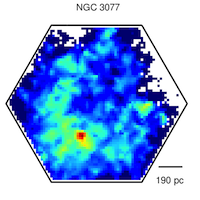 |
The Reach of Stars: Tracing the interaction length of Stellar and AGN Radiation in the ISMThe temperature and corresponding phase transitions of the interstellar medium (ISM) play key roles in the formation of stars, and thus galaxy evolution. However the physical processes involved are still not fundamentally understood: the cooling of the ISM to enable star formation, and the in turn heating of the ISM by the stars that form. ISM cooling is known to depend upon the local conditions, while ISM heating is connected to the distribution of stars, yet the exact scales on which these physical processes occur is still an open question. The Herschel Infrared Space Observatory is now enabling major breakthroughs in the understanding of these physical processes, providing spatially resolved maps of the interstellar dust, and the atomic and molecular emission, within galaxies, thus tracing the heating and cooling of the ISM, respectively. This proposal will take full advantage of Herschel to conduct an in-depth study of the ISM, combining exquisite infrared observations of nearby galaxies with state-of-the-art models. Using privileged access to KINGFISH, a legacy dataset of 61 galaxies, and data from our neighbour, the Andromeda galaxy (M31), we aim to measure the "The Reach of Stars". Funding is requested for one post-doc and one student to study; a) the cooling mechanisms of the ISM using molecular and atomic emission lines, and b) ISM heating from the scales of molecular clouds and up, respectively, and reconcile these with the observed distribution of stars.Groves, Kreckel, Schinnerer |
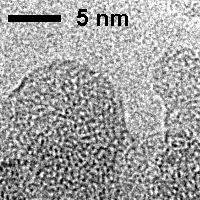 |
Experimental studies on the low-temperature condensation of cosmic dust in the interstellar mediumIn the interstellar medium (ISM) of our galaxy, the cosmic dust destruction rate is higher than the dust formation rate in circumstellar shells. The amorphous dust grains, including silicates and carbonaceous materials that form the bulk of interstellar dust, must therefore be the result of grain condensation and growth at low temperatures and densities in the presence of ultraviolet radiation. Such condensation conditions are far from those present in circumstellar shells of evolved stars and far from being understood. Condensation processes at low temperatures and pressures have to be studied in the laboratory to obtain better insight into the problem of grain formation at the extreme conditions in the ISM. In our experiments, atoms, clusters, and molecules representing the reaction products of destructive processes in the ISM will be evaporated from bulk siliceous and carbonaceous solids and deposited on cold substrates with temperatures between 6 and 20 K. These substrates simulate the cold surfaces of survived dust grains and can be siliceous or carbonaceous material. Reactions between the adsorbed species will be triggered by UV irradiation. The heterogeneous nucleation processes and the formation of larger molecules, oligomers, and solid layers will be monitored by different methods including UV-vis/IR spectroscopy and electron microscopy. Energy dispersive X-ray analysis (EDX) has to be used to determine the final composition of the grains. Finally, spectral properties of the produced grains and efficiencies of grain growth will be estimated. The results will help to comprehend the compositional, spectral, and structural properties of freshly formed interstellar dust particles, which influence energetic processes in the ISM, and to understand the relation between solid circumstellar and interstellar materials.More information... Henning |
 |
Charged particel transport in interstellar plasmas: Improved theory for scattering of cosmic rays in turbulent fieldsCosmic rays, charged dust particles and turbulent magnetic fields are important constituents of the interstellar medium. Understanding and predicting the transport of charged particles in turbulent media is a key challenge in a number of related disciplines, ranging from magnetic confinement fusion research to astrophysics. In astrophysics, it is the scattering, acceleration and spatial diffusion of cosmic rays in interstellar magnetic fields. The purpose of this proposal is two-fold: First, we want to investigate the transport of fast particles in cosmic magnetic fields, applying scaling concepts which were developed recently in the context of tokamak physics based on the percolation theory. This can be done since although the turbulent scales are extremely different, the scattering mechanisms perpendicular to the background field are basically the same. Secondly, we want to develop an improved weak turbulence transport theory of fast charged particles in a partially turbulent magnetic field, that avoids the usually made quasilinear approximation to the particle orbits, and properly takes into account recent nonlinear improvements. Three statistical properties of the magnetic turbulence are adopted: (1) quasi-stationary turbulence, (2) the existence of a finite turbulence decorrelation time, and (3) spatially homogenous turbulence. In contrast to the scaling theory, weak turbulence transport theories often make use of the Corrsin independence hypothesis allowing one to express a fourth order correlation function in terms of the product of two second order correlation functions. Two central goals of this proposal are (1) the calculation of cosmic ray scattering rates from weak turbulence and scaling transport theories, respectively, and (2) their comparison to verify or disprove the validity of the Corrsin hypothesis for cosmic turbulent magnetic fields. The so improved transport theory will be applied to selected interstellar phenomena such as the diffusive shock acceleration of cosmic ray particles in the presence of large scale parallel spatial gradients of the guide magnetic field.Jenko, Schlickeiser |
 |
Connecting the Large-Scale Molecular Cloud Structure and Star FormationThe cold and dense molecular clouds are present "everywhere" in the Universe, providing environments where new stars can be born. There is an intricate connection between the structure of such clouds and star formation. On the one hand, the molecular cloud structure is borne out by the physics and processes related to star formation. On the other hand, the star formation itself is driven, and many properties of stars decided, by the structure of the molecular clouds. How exactly the star-forming structures inside the clouds come to be, and what are the physics driving their formation and evolution, are fundamental open questions in the physics of the cold interstellar medium and star formation today. This project will study the connection between the molecular cloud structure and star formation by quantifying the physical processes acting in molecular clouds in a very early stage of their evolution, even prior to active star formation. Such stage of cloud evolution has not been studied widely in the past, despite its defining impact on the star formation in the clouds. The project will generate a unique observational picture to the structures of these clouds. The characterization of the clouds will be done over a wide spectrum from local, low-mass clouds to more distant, potential high-mass star-forming clouds. The results will be interpreted with the help of numerical work simulating the physics of the turbulent interstellar medium, and from therein they will elaborate the connection between the structure of the cold and dense interstellar medium and the star formation process.Kainulainen |
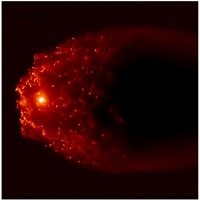 |
Effects of Massive Stars on Their SurroundingsMassive stars are the cosmic engines which drive the evolution of galaxies throughout the history of the universe. This project will undertake a detailed investigation of the effects of stellar winds, ionising radiation, and the final stellar explosions on the interstellar medium. Building on our experience in simultaneously modelling the evolution of static rotating massive stars and their circumstellar medium, we will for the first time advance such studies to the more realistic situations of moving stars, and high pressure and inhomogeneous external media. In a second step, we will initiate supernova explosions into these pre-calculated environments whose properties emerge from the corresponding pre-supernova evolution. We will then calculate the observable and dynamical consequences of interactions of supernovae with their surrounding medium for the most frequent realistic situations. Our models will be compared to observations of runaway star bow shocks and wakes, nebulae around massive stars within stellar clusters, sizes and shapes of wind-driven shells in different environments, and supernovae and supernova remnants. They will quantify the energy, momentum, ionising photon luminosity, and chemical elements delivered by massive stars, which are essential ingredients for understanding the evolution of the interstellar medium.More information... Langer, Mackey |
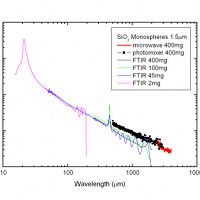 |
Laboratory measurements of the far-infrared to millimeter dust opacity at low temperaturesThe thermal emission of cold dust in the far infrared up to the millimeter range is an important source of information for studies of the spatial distribution of the interstellar medium. The interpretation of observations in this spectral range, as they are performed with Herschel and Planck, depends on the exact knowledge of the emission properties of the dust particles, i.e. the dust opacity. The available opacity data, however, are based on relatively few laboratory measurements for some selected materials only and on a still quite poor understanding of the underlying physical effects. Although the strong influence of temperature on the sub-millimeter opacity is known in principle, so far only a few measurements at low temperatures have been carried out. The aim of the project is to broaden this data base by laboratory measurements on important interstellar-dust materials such as amorphous silicates of different iron content and for mixtures e.g. of silicate and carbon- or iron-based materials. The influence of temperature, of inhomogeneous compositions and of particle agglomeration on the opacities will be investigated in detail.More information... Lewen, Mutschke |
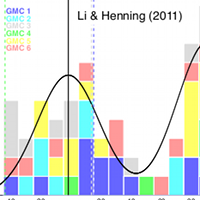 |
The Anisotropy in Interstellar MediaGravitational contraction, turbulence, and magnetic fields (B-fields) are generally accepted to be the key dynamical processes involved in interstellar media (ISM). How these processes interact with each other to form clouds, cores, and stars is, however, highly controversial. Many parameters that have been defined to describe these processes are isotropic (e.g., turbulent velocity, magnetic pressure, and virial equilibrium), but very recent observations have begun to reveal that density fragmentation and turbulent velocity in ISM may be highly filamentary. At the same time, Galactic B-fields have been found to be strong enough to imprint their orientations in many molecular clouds. These kinds of observations can place crucial constraints on competing ISM scenarios, because not all of them predict the observed anisotropy. Additional observations to increase the sample size are proposed here, along with new experiments designed for the forthcoming instruments and surveys. The challenge of understanding the ISM dynamics owes much to the lack of a practical method for measuring B-field strength. The novel method we proposed recently, based on the difference between ion and neutral turbulence, will be applied to filamentary density structures in molecular clouds. The method can simultaneously measure the energies of turbulence and B-fields, which will greatly help our understanding of the causes of ubiquitous cloud filaments.More information... Li |
 |
The impact of radiation pressure and from massive stars on the turbulent interstellar medium in extreme environmentsFor the highly turbulent interstellar medium in extreme environments, like gas-rich high-redshift disks and interacting galaxies, radiation pressure - the absorption of starlight by interstellar gas/dust - is supposed to dominate cloud disruption and can be the main launching mechanism of observed large scale galactic winds. The proposed project is aimed at understanding this fundamental wind driving process with numerical simulations at its origin, the parental giant molecular cloud which is not accessible by direct observations. We propose to systematically investigate the impact of energy input from massive short-lived stars by ionization and radiation pressure on the turbulent ISM and will use high-resolution three-dimensional simulations - including gravity, hydrodynamics, and radiation transfer - of the feedback from massive stars embedded in turbulent molecular clouds including, for the first time, a self-consistent modeling of the coupling of starlight to the interstellar gas/dust and the resulting momentum input. The effect of this feedback process on the star formation efficiency, cloud lifetimes, turbulence, and wind driving will be investigated.Naab |
 |
HII regions and triggered star formation in the turbulent ISMWe propose a detailed investigation of the impact of ionizing radiation from massive stars on star-forming, turbulent molecular clouds, i.e. how, and under what circumstances, massive stars may trigger, or accelerate and then terminate star formation. Self-sustained, triggered star formation in a turbulent ISM of different statistical properties may lead to the formation of one or more massive stars triggered by an initial HII region, these stars will again cause new HII regions and may trigger subsequent star formation. For the first time we will thoroughly investigate the formation of multiple generations of HII regions in high-resolution, three-dimensional, gravo-turbulent simulations of molecular clouds with different initial structure. The simulations will be compared in detail to available and new observations with high spatial and spectral resolution with Spitzer, Herschel, and ALMA. For this purpose we will employ different radiative transfer methods to produce continuum and line emission maps as well as spectral energy distributions. The simulations as well as the maps will be made available to the astrophysical community via the Astronet database for star formation.Naab |
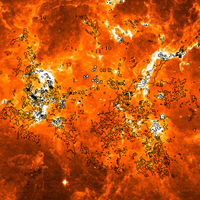 |
Comparing turbulent structures in models and observationsLarge surveys in the different tracers for the ISM (dust continuum, HI 21cm, low-J CO, [CI] and [CII]) have become available or are going to be observed in the near future with new observatories and instrumentation. In parallel, numerical (M)HD-simulations have matured to a state where they cover a relevant range of spatial scales in full 3D-treatment and address different physical scenarios for the driving, development, and dissipation of turbulence. To compare observations and simulations, a large suite of sophisticated statistical measures of the turbulent structure of interstellar clouds have been developed and are being applied. In this project we will systematically compare statistical properties of large scale mapping observations of ISM clouds in the different tracers with simulated observations based on turbulence models. The different statistical tools are going to be combined to resolve various aspects in the characterisation of interstellar turbulence: on the one hand the observational bias introduced by the limitations of any measured data set obtained with today's observational technology, on the other hand physical mechanisms such as the phase transition from atomic to molecular gas at cloud boundaries, strong deviations from local thermodynamic equilibrium, dynamical instabilities driven by induced pressure gradients, and the so-far unknown impact of the radiation pressure from the interstellar radiation field.More information... Ossenkopf, Simon |
 |
Stellar ISM dust sources: Carbide dust formationDust particles play a central role in the astrophysics of the interstellar medium (ISM) - from chemistry and thermodynamics of the gas up to the dynamics of star formation. The lifecycle of the interstellar dust starts with the nucleation and growth of grains in steady winds or explosive ejecta of stars. Asymptotic giant branch (AGB) stars and type II supernovae (SNs) are particularly rich in detected dust compounds. Low and intermediate mass stars are thus among the most important dust sources in the interstellar medium of galaxies and the composition of dust ejected from these stars affect those in the ISM. Dust grains formed in such circumstellar envelopes are rather a mixture of several chemical elements as verified by many investigations of presolar stardust grains enclosed in meteorites, which are differentiated in carbon-rich and oxygen-rich solid materials. The main objective of this research project is the detailed theoretical study of the formation of carbide dust particles in circumstellar environments focussing mainly on the microphysical aspects of the nucleation and grain growth processes. In this context especially the role and importance of titanium carbide and silicon carbide in carbon dust formation is addressed. The unique characteristic of this research project is thereby that the complex multi-component dust growth is combined with the competitive treatment of different nucleation processes of the condensing materials. The knowledge of these processes is also important for understanding other dusty astrophysical environments.Patzer |
 |
Deciphering the interstellar medium around the Scorpius-Centarus OB associationWe propose to study the complex structure and evolution of the interstellar medium (ISM) in the vicinity of the Scorpius-Centaurus OB association. As this is the nearest region of recent massive star formation, the numerous available multi-wavelength observations provide a unique opportunity to investigate in detail how the well known population of massive stars of Scorpius-Centaurus feeds the ISM with kinetic energy, ionizing radiation, and nucleosynthesis ejecta and how this feedback destroyed the parental molecular cloud. We will test the scenario that this stellar feedback also swept up new dense molecular clouds and triggered the formation of new generations of stars in these clouds. The MPE population synthesis code will be coupled with hydrodynamical simulations in order to follow radioactive tracers, ejected from the massive stars as an independent signature of the evolution of the interstellar environment and the mixing of different gas phases. The theoretical predictions will be compared with observations of radioactivity gamma-rays as measured with the INTEGRAL satellite. We aim to make accessible the full variety of astronomical observables across all wavelength regimes, including radioactivity gamma-rays, X-rays, far-infrared dust emission, neutral and ionized gas as measured with HI and Hα, and free-free emission as an ionization tracer. Funding is requested for a theoretical/numerical position on the PostDoc level and for two PhD students who should work on the observational data and implementations of specific hypothesis tests.Preibisch |
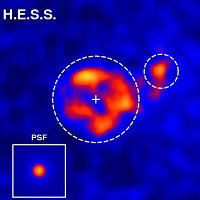 |
Supernova Remnants: TeV emission from sources of nonthermal interstellar medium energyThe matter that is ejected during a supernova explosion into interstellar space creates an extended object which is called supernova remnant. In the outward moving shock waves that form in such a remnant, particles are accelerated to very high energies. Latest at the end of the supernova remnant's lifetime, all these particles are released into interstellar space. The particles fill up our entire Galaxy and are detected as cosmic rays when they bombard Earth from all directions. In the proposed project, astronomical observations of such supernova remnants and their surroundings in our Galaxy will be used to investigate these high energy cosmic ray particles as they are accelerated and subsequently leave the accelerating sites. To observe these highly energetic particles, associated photons with TeV energies need to be detected (1 TeV = 1,000,000,000,000 times the energy of a visible photon). TeV photons are best observed with ground-based Cherenkov telescopes, such as the High Energy Sterescopic System H.E.S.S. With a thorough understanding of the paths of these particles as they are accelerated and injected into interstellar space, using both observations and supernova remnant models, the project aims at setting the stage for investigations of the interstellar medium at locations where the density of these cosmic ray particles is highest.Image taken from A. Abramowski et al for the H.E.S.S. Collaboration: "A new SNR with TeV shell-type morphology: HESS J1731-347", Astronomy & Astrophysics 2011, Volume 531, A81 Pühlhofer |
 |
The Structured Interstellar Medium: Infrared-dark clouds from Herschel to ALMAMolecular gas makes up the smallest volume fraction of the phases of the interstellar medium (ISM), yet it is of paramount importance in the formation of stars. The densest condensations in molecular clouds are confined to filamentary structures in the Galactic plane; the most striking of these structures are infrared-dark clouds (IRDCs), which reside in the spiral arms where the molecular gas distribution in the Milky Way peaks. IRDCs are thought to be the birthplaces of rich star clusters. Star formation in IRDCs is poorly constrained because light from embedded protostars is heavily obscured by dust. For the first time, Herschel now provides high-resolution access to the far-infrared, where the extinction by dust lessens. This proposal aims to connect the small structures seen by Herschel to large-scale filaments in order to understand the conditions under which IRDCs fragment and ultimately form stars using Herschel, Spitzer, and millimeter (line and continuum) observations of a well-studied sample of IRDCs. We will also conduct a survey of high-resolution molecular line maps using the Plateau de Bure Interferometer and ALMA that will help constrain the kinematics in IRDCs at various stages of their fragmentation. This suite of observations will test predictions of molecular cloud simulations using radiative transfer modeling. By providing powerful observational constraints on models of IRDCs, this project serves as a bedrock for forming a coherent model of the densest phase of the ISM.Ragan |
 |
On the nature of highly ionized gas in the circumgalactic environment of galaxiesA thorough understanding of the distribution and physical nature of highly-ionized gas in the outer regions of galaxies is of crucial importance to characterize the matter exchange between the interstellar gas in galaxies and the intergalactic medium. In this project, we will use high-resolution smoothed particle hydrodynamic (SPH) cosmological simulations from the so-called OverWhelmingly Large Simulations (OWLS) project to study the properties of highly-ionized gas in the circumgalactic environment of low-redshift galaxies. We will generate synthetic absorption spectra of high ions such as OVI, Ne VIII, and others along sightlines passing through the large-scale environment of galaxies and study the absorption characteristics, filling factors, and physical conditions in the circumgalactic gas component. The statistical properties of the synthetic spectra then will be compared to quasar absorption-line data of low-redshift OVI absorbers from FUSE and HST. Our project is aiming at a better understanding of the physical nature of the highly-ionized gaseous envelopes of galaxies and their connection to the multi-phase, multi-scale interstellar medium and the cosmic web.Richter |
 |
Laboratory measurements on cold electron reactions with key species of interstellar chemistry using ion beamsIn the chemical network of the interstellar medium binary reactions involving charged particles (atomic ions, polyatomic molecular ions and electrons) are crucial driving mechanisms at temperatures and densities much below standard laboratory conditions. In order to obtain and improve laboratory data on such processes, event-by-event reaction studies with stored ion beams are proposed on low-energy recombination reactions between ions and electrons in particular. By combining the counting of individual reaction products and the imaging of multiparticle fragmentation with the use of cold photocathode electron beams, such studies have been successfully realized in recent work. For cold ion chemistry processes, however, they hit limitations due to the room-temperature thermal radiation and too short beam storage lifetimes. It is hence proposed to implement the technique at the cryogenic electrostatic storage ring CSR, which will offer much more favorable conditions for the study of processes in cold ion chemistry through the cryogenically cooled surrounding of the ion beam and much longer storage lifetimes. Data will be obtained for dissociative recombination of polyatomic molecular ions with cold electrons at much reduced initial rotational excitation, unaffected by room-temperature thermal radiation, and for dielectronic recombination of heavier singly charged atomic ions with a strongly improved sensitivity for the highly excited Rydberg atoms formed. The project opens up CSR as a unique laboratory for the study of ion chemistry in the interstellar medium.Schippers,Wolf |
 |
The Formation of Giant Molecular Clouds and their Associations: Confronting Theory with Observations in the Spiral Arms of M51Although first empirically established the relation between radio and infrared continuum emission has provided critical insight in ISM (interstellar Medium) properties and their dependencies on magnetic fields, star formation and nuclear activity, density waves, and others. Only recent improvements in radio and infrared instrumentation allow us to use this important tool on local scales to gain new insight into the ISM properties on sub-kpc scales. Our recent study of the local radio-IR relation in M51 reveals two interesting regimes within M51's disk: a) the radio-IR relation is sub-linear in the inter-arm and outer disk regions (seen for the first time), and b) the supposed interaction region between the two galaxies shows enhanced radio continuum without corresponding IR emission. We request funding for one PhD student to conduct in-depth studies of these two areas to a) reveal the underlying physical cause for the sub-linear relation found in M51 with possible candidates such as dust temperature/opacity, diffusion length/escape time of cosmic ray electrons, magnetic field properties, and b) determine the physical properties of the interaction region such as size, shock strength, time since collision, plus the properties of the cold ISM to estimate if such collisions have a major impact on the cold ISM component. Further it is planned to expand the first study to two more nearby spiral galaxies (NGC628 and NGC6946) to test the universality of the M51 findings.Schinnerer |
 |
The interplay between IRDC Formation and the Birth of Massive StarsInfrared Dark Clouds (IRDCs) are dense clouds of gas seen as absorption features against the Galactic plane. Due to their high densities, large masses and low temperatures, IRDCs are thought to be young molecular clouds which are just beginning to form stars. In this project we seek to study how effectively IRDCs are formed from gas that passes through the spiral shock of a galaxy, and the implications of this formation process upon the evolution and future star formation within the cloud. Many IRDCs appear to be forming massive stars, but it is unclear whether this is a ubiquitous outcome of IRDC formation. By performing numerical simulations of a range of IRDCs, we plan to address how common massive star formation is in these objects. In order to achieve these goals, we will use cutting edge numerical techniques to follow the entire early life cycle of the IRDCs, from formation out of the diffuse ISM, to the formation of the first massive protostars. By using a time dependent chemical network we will accurately capture the local thermodynamics, self-consistently follow the formation of the molecules within the dense gas, and derive abundance maps of the IRDCs. This will enable us to create publicly available, synthetic observations of our simulations which will be of considerable use when interpreting the results of current and future IRDC observations from facilities such as Herschel and ALMA.Smith |
 |
The impact of protostellar outflows on the interstellar matterTurbulent support of molecular clouds might be one solution to the problem why the observed star formation rate is much lower than expected if molecular clouds would collapse on their free-fall time scale. The prerequisite, however, is that the turbulent energy which is being dissipated in shocks can be replenished. Protostars eject a certain fraction of the descending matter by bipolar jets and outflows at high speed. Thus, they are considered as potential drivers for stirring the turbulence. However, there are controversial views in the literature whether or not jets and outflows can provide sufficient input to actually stabilize clouds. In order to help clarifying the role of outflows in this context we propose a thorough study of the impact of protostellar outflows on the ISM. In order to assess physical parameters of outflows such as energy and momentum we will combine near-infrared and radio data of welI-investigated regions, use excitation models to account for missing transitions, and keep the time-variability of the flows as well as their geometry in mind. We will apply the derived results for outflows identified in H2 surveys (GLIMPSE follow-up, UWISH2) to improve the overall statistics. Moreover, we propose to specify and procure H2 filters for VISTA to perform a southern wide-field Galactic plane survey which will supplement ongoing/future ISM studies with Herschel, and ground-based facilities, e.g. ALMA.Stecklum |
 |
The physics and chemistry of low-mass coresLow-mass molecular cloud cores are the birthplaces of solar-type stars. Therefore, a thorough understanding of star-formation requires detailed knowledge of their initial properties. Nearby, small and isolated clouds, like Bok globules, are ideal laboratories for studying the physical and chemical properties of such star-forming cores because they are free from the complicating effects present in more clustered star-forming regions and are relatively straight-forward to model. Despite this relative simplicity, we still lack robust measurements of two fundamental physical parameters of such cores: temperature and density. These two parameters regulate the chemical and dynamical evolution and the subsequent gravitational collapse and fragmentation. The data from our Herschel project "EPOS" allow us for the first time to directly measure the temperature and density structure in a sample of 14 isolated star-forming cores. In order to measure gas-grain coupling processes and the role of turbulence and magnetic support, we have already acquired a set of complementary molecular line maps of different CO isotopes and N2H+ and propose further observations of at least NH3, CS, HCO+. When combined, these observations present the unique opportunity to model, in an unprecedented way, the chemical and dynamical state of the densest and coldest star-forming units in the interstellar medium. Our aim is to derive a new - coherent - modeling approach in which the highly accurate physical structure derived from the dust continuum data serves as independent input for the state-of-the-art chemical models, which in turn allow us to constrain the chemical evolution of such star-forming cores.Stutz |
 |
Quantifying ISM Turbulence in Nearby Galaxies on 100 pc ScalesThe origin of interstellar turbulence has been a puzzle for decades. Investigating the possible mechanisms that drive the turbulence in the interstellar medium (ISM) of galaxies on scales of giant atomic complexes (~100 pc) and below are the focus of numerous theoretical studies and lies at the heart of the newly installed ISM-SPP. However, even though turbulence is a fundamental property of the ISM that needs to be modeled, there is a clear lack of observational data to constrain turbulence in a representative sample of nearby galaxies on the spatial scales of interest. The goal of this project is in principle simple: to measure interstellar turbulence and its dependence on local environment on scales of ~100pc, capitalizing on (a) three newly available state-of-the-art large VLA HI surveys of nearby galaxies (totaling more than 100 galaxies with exquisite available HI data), (b) newly developed mapping routines that greatly enhance the dynamic range in radio interferometric imaging, critically needed for the proposed analysis and (c) a sophisticated toolbox that is needed to go beyond previous turbulence studies. The PI has contributed significantly to the groundwork needed for this analysis (points a-c) and requests 3 years of funding for one PhD position for this project. The results of this study, quantifying turbulence on 100 pc scales reliably in a large sample of more than 100 extragalactic environments, will be of direct relevance to many ongoing theoretical and numerical ISM studies within the ISM-SPP.Walter |
 |
Unveiling the multi-scale structure of the magnetic field in the interior and the environment of molecular cloudsThe goal of this project is to evaluate the potential of continuum polarization measurements to constrain the impact of magnetic fields on star-formation in molecular clouds. The current proposal is focused on the analysis of the potential of multi-wavelength high-spatial resolution continuum polarization measurements for constraining the multi-scale structure of magnetic fields in the interior and the environment of molecular clouds. We will go beyond previous approaches in this field by making use of the self-consistently simulated density, temperature, velocity, and magnetic field structure in molecular clouds and cloud cores, resulting from magneto-hydrodynamical simulations and subsequent three-dimensional radiative transfer simulations. Furthermore, currently developed grain alignment theories, considering the effect of anisotropic radiation fields, e.g., originating from embedded stars, will be applied. Different types of continuum polarization mechanisms which can be traced at optical to millimeter wavelengths will be considered as well as correlations between these and other observables in the different wavelength regimes. The results of this study will provide constraints for the accuracy, spectral coverage, and spatial resolution of polarization measurements required to constrain the multi-scale magnetic field morphology in molecular clouds.More information.. Wolf, Banerjee |
 |
Dust formation and cycle in the Interstellar mediumInterstellar grains cycle in the ISM between the warm intercloud medium and cold dense clouds on short timescales. In the warm medium grains are subject to destruction in fast Supernova shocks that has to be balanced by an efficient source of dust formation operating on timescales less than several hundred Myr. While stars eject dust in the ISM on much longer timescales, grain growth by mantle accretion in cold clouds can operate relatively fast and explain observed variations of dust abundances in the ISM phases. One of the key questions is how the distinct oxide/silicate and carbonaceous grain populations are preserved with accretion of mantles out of a homogeneous interstellar mixture. In this project we intend to investigate the interstellar conditions under which (i) silicate grain surface remains clean from volatile ice mantles and (ii) collision timescales are sufficiently long for the preferential accretion of Si, O and Mg atoms. We will also develop a new recipe for the dust destruction that accounts for clustering of massive stars. With more accurate treatment of dust growth by accretion and destruction in the ISM implemented in the global model of dust evolution we will be able to gain a deeper insight into the formation, destruction and cycle of grains in the ISM of our galaxy and objects in the young Universe.Zhukovska |
 This priority program is funded by the German Research Foundation DFG.
This priority program is funded by the German Research Foundation DFG.
